One should cover a pan while heating?
The legend
You should always cover a pot of water you want to boil, so that it boils faster.In other words, if you're heating water (or anything else), boiling is achieved more quickly if the pan is covered than if it's not.
How to check?
Boil 1 liter of water in a covered pan, timing the time, then 1 liter of water in an uncovered pan, again timing the time.Comparing the times will show whether you really need to cover the pot to go faster.
Let's check:
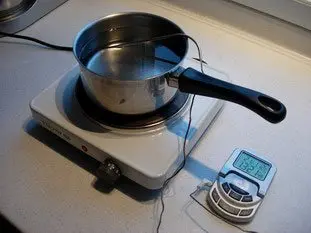 We measure 1 liter of water and place it in an uncovered saucepan on a hotplate, into which we dip a thermometer.
We measure 1 liter of water and place it in an uncovered saucepan on a hotplate, into which we dip a thermometer.
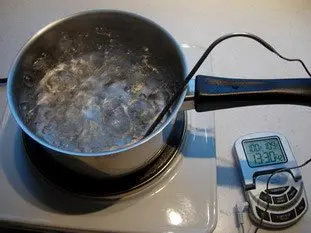 Turn on the stove and start the timer, reaching 100°C (210°F) in 9 minutes and 30 seconds.
Turn on the stove and start the timer, reaching 100°C (210°F) in 9 minutes and 30 seconds.The stove is left to cool down for about an hour, returning to room temperature.
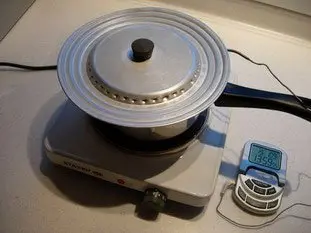 Another 1 liter of water is measured and placed in a covered saucepan on the stove, still using a thermometer.
Another 1 liter of water is measured and placed in a covered saucepan on the stove, still using a thermometer.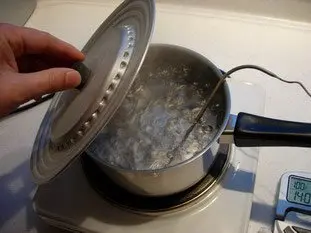 Turn on the stove and start the stopwatch, reaching 100°C (210°F) in 9 minutes and 27 seconds.
Turn on the stove and start the stopwatch, reaching 100°C (210°F) in 9 minutes and 27 seconds.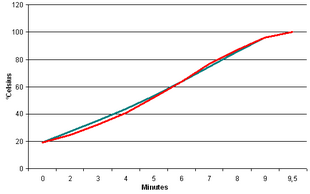 The result is even more obvious if you compare the temperature curve, with the uncovered pan in red and the covered pan in green.
The result is even more obvious if you compare the temperature curve, with the uncovered pan in red and the covered pan in green.Conclusion
The time difference is too small to be significant: covered or uncovered, it's practically the same thing.Some people have pointed out to me that if we were using a (much) larger volume of water, it wouldn't be the same; the lid would be effective, but in home cooking, we only use small volumes.
To sum up:"You should always cover a pot of water you want to boil, so that it boils faster", is not true.
Lasts posts
The importance of sieving
In recipes that use a fine powder (flour, powdered sugar, etc.), you'll often see the advice to sift before using it. To sift is to pass the powder in question through a sieve (a very fine strainer) before incorporating it into your recipe. It's often advice, but is it really useful?September 3rd 20256,5223
The grease spray
As soon as you have something in a recipe that sticks to the mold, the question always arises as to how difficult it is to remove from the mold. There's nothing more frustrating than breaking your cake when unmolding it, because part of it has stuck in the mold. The classic way to avoid this is...August 26th 20255,9315
Cake moulds
When we make a cake, or a cake of the same rectangular shape, we usually take out our usual mould and tell ourselves that the recipe is anyway "for a cake", but is it really that simple?August 25th 20256,1465
Thinning out herbs
If you need to add a long-stemmed herb (tarragon, mint, verbena, thyme, etc.) to a recipe, you'll probably only need the leaves and not the stem, so you'll need to remove the leaves. Leaf removal means keeping only the beautiful leaves, and eliminating the ugly stems and leaves, but how do you do...August 8th 20254,3265
Add a bay leaf
Bay leaf: small in size, but big in flavor. You'll find it in hundreds of recipes, and it's often added to cooking meat, in a sauce or broth, usually accompanied by other herbs or products. It's a staple of Provençal, Mediterranean and Oriental cuisine, but not the only one. Usually, in a...July 31th 20254,3515
Other pages you may also like
The importance of sieving
In recipes that use a fine powder (flour, powdered sugar, etc.), you'll often see the advice to sift before using it. To sift is to pass the powder in question through a sieve (a very fine strainer) before incorporating it into your recipe. It's often advice, but is it really useful?September 3rd 20256,5223
Coarsely chopped herbs
Although we are in the middle of winter as I write these lines, you should not hesitate to make salads at this time, it is actually quite simple, rather fast, and so pleasant. A while ago, I already told you that a salad is a salad, but a salad with herbs is immediately something much better:...January 9th 202114 K4.9
Too much sweet and savoury
There is a food trend which is creeping in everywhere in France right now: mixing sweet with savoury. In some restaurants, it is becoming difficult to order a classic dish, like “roast veal” for instance, without being served fruits in the garnish or honey/conserves/syrup in the sauce or cooked...November 3rd 201127 K4.5
Your oven in "proofer" mode
In the bakery, proofing is a crucial stage in the process of making light, plump breads and pastries. During proofing, the yeast ferments the sugars present in the dough, releasing carbon dioxide which forms bubbles. This process allows the dough to swell and aerate, guaranteeing a soft, light...September 27th 20249,4625
What is the difference between bakery and patisserie?
This is a question that you may well have asked yourself and which I will attempt to answer. In France the two trades of "boulangerie" (bakery) and "pâtisserie" (patisserie and confectionery) have always been quite distinct, but where exactly do the boundaries lie? .February 7th 2017132 K 14.1
Follow this page
If you are interested in this page, you can "follow" it, by entering your email address here. You will then receive a notification immediately each time the page is modified or a new comment is added. Please note that you will need to confirm this following.
Note: We'll never share your e-mail address with anyone else.
Alternatively: you can subscribe to the mailing list of cooling-ez.com , you will receive a e-mail for each new recipe published on the site.









The 1 comment already posted on this page